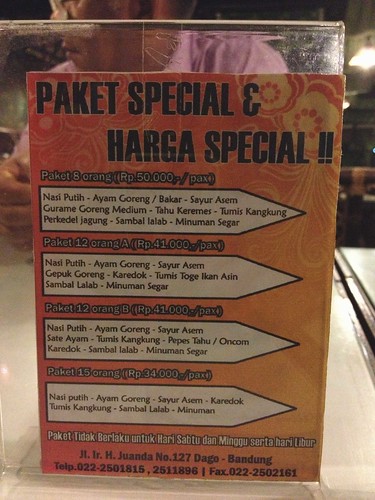
We chose the 3rd set
Seeing that these packages aren't offered on weekends and holidays, well, we're just glad to be travelling on weekdays.
We added on another 3 sets of grilled fish and chose watermelon juice.
At a little more than SG$6 per head for that much food at an established restaurant, it's quite a steal!
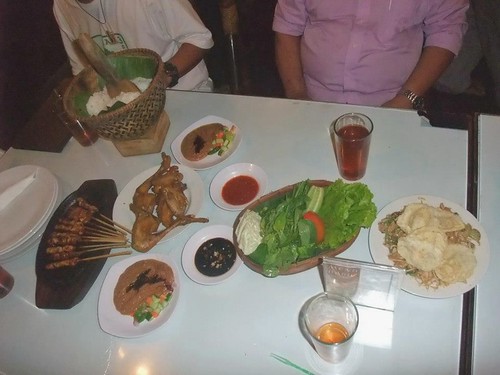
Initially served
We were served this rather not-so-sweet tea and the rice was served in this basket lined with banana leaf. The whole set-up was completed with a carved, wooden scoop.
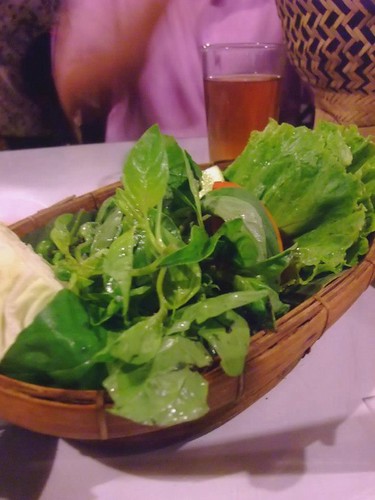
Lalab
Mention Sundanese food and this will come to mind. A platter of raw greens which include the likes of cabbage, lettuce, basil (kemangi), tomato and mini cucumbers (timun lalab/padang).
I really look forward to this and will 'attack' those greens with gusto. Refreshing… satisfying!
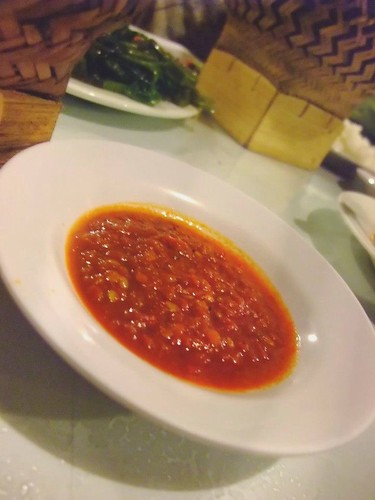
Sambal terasi
Or as the Malays will call, "Sambal belacan" (chillies grounded with shrimp paste). An accompaniment for the 'Lalab', actually.
As you can see, there's a rim of oil around the sambal. Unlike the Malays, Javanese folks actually fry their ingredients a bit before they make it into this chilli paste (sambal). And they also add tomato.
Aside from this 'sambal terasi', we were also served 'sambal kecap' (sweet soy sauce with chopped birds-eye chillies and shallots).
'Oncom' is a by-product from the production of other foods that's almost similar to the popular 'tempe'. It is usually derived after the processing of either soybeans (tofu), peanut, tapioca or even coconut products.
There are 2 variations of 'oncom', namely the red and black. The difference is due to the type of product and bacteria (yeast) used to ferment it. I asked my domestic helper, who's a big fan of 'oncom' and she told me that the red one taste better and has better texture.
'Pepes', meanwhile is where a food item is packed in banana leaf with spices and then cooked by either steaming, boiling or grilling. Also known as, 'Pais'.
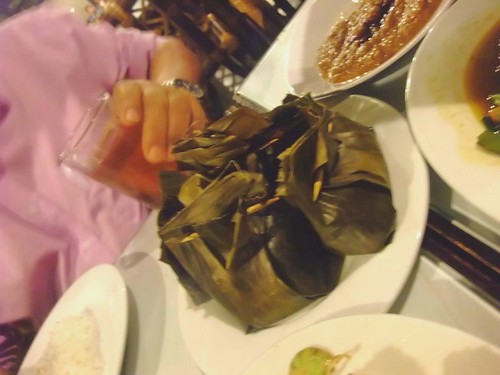
Pepes tahu
This one has cubes of tofu that appeared freshly made. Soft, yet spingy.
Both the Pepes Oncom & Tahu were steamed with spices that tastes slightly different and compliment both ingredients nicely. Both taste really good with piping hot, fluffy white rice.
Mixing some 'oncom' into the rice reminds me of 'Nasi Tutug', somehow. Another Sundanese speciality where rice is mixed with 'oncom'.
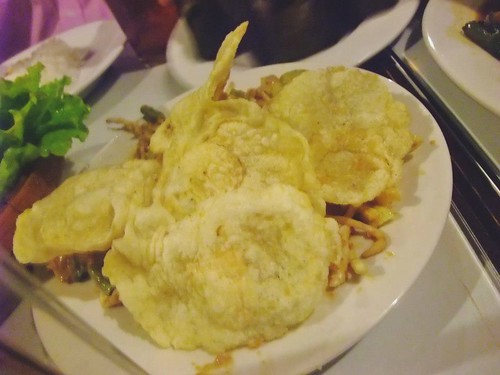
Karedok
I should have flipped over, one of those 'emping melinjo' (crackers made from 'melinjo/belinjau' nuts) over so that you can see what this dish is all about. Another Sundanese food icon, it's almost similar to the 'Gado-gado' that we're more familiar with, save that the veggies here are mainly raw.
Unlike the 'gado'-gado' which has blanched veggies, boiled potato and bite-sized pieces of fried tofu & tempe, 'karedok' had raw sliced/chopped veggies like cabbage, bean sprout, long beans, basil and eggplant (usually 'terung pipit').
The peanut sauce is similar to 'gado-gado', with a strong hint of 'kencur' (aromatic ginger).
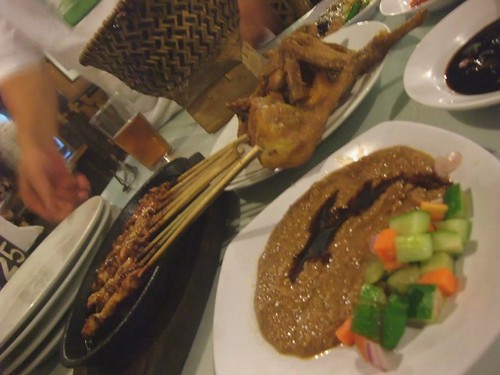
Sate ayam & Ayam goreng
Ten sticks of chicken sate (satay) were served on a hotplate and the accompanying sauce was slightly different that what we're used to. One thing is that it's kinda sweet. Maybe attributed by that sweet soy sauce they drizzle on top...
The sate itself... wow! It's just so delish! Kiddo alone had 3 sticks, I think.
Here in SG, I get my Indonesian-style satay/sate fix from Waroeng Penyet. Soo nice..(and expensive)!
The fried chicken comes in large pieces and is marinated simply, if marinated at all. But they're a hit with the kids.
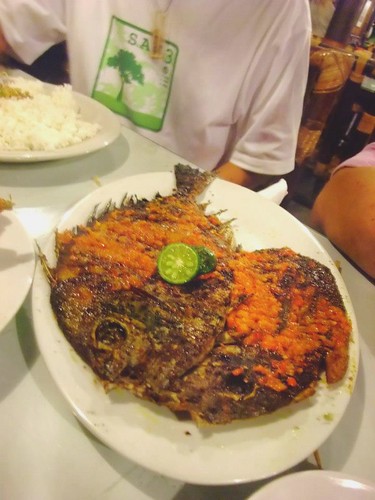
Ikan Baronang bakar
'Baronang' is a type of saltwater (sea) fish that's popular in Central Java region. It's also known as 'rabbit fish'.
Here, the fish is butterflied and then grilled, before being slathered with this delightful tangy, spicy sauce. My BiL was so crazy about this dish that he went around to see if there were any left-overs from the other side of the table.
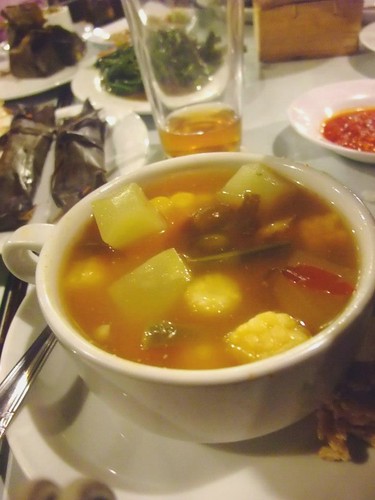
Sup sayur Asem
Yet another Sundanese food icon. Sour, salty, spicy and slightly sweet soup consisting of an array of vegetables like 'labu Siam' (chayote), 'daun melinjo', cabbange, long beans, corn (both baby & sweet corn) plus nuts like groundnuts and whole 'melinjo' nuts.
My MiL complained that the soup is 'too sweet', unlike the normally sour-spicy-salty type that she normally cooked. I told her that Sundanese food has always been a wee bit sweet. She then decide that she dislike Sundanese food in general. "Already so sweet, still serve 'kecap manis'!"
Haha. And you know the irony? My MiL, she's Javanese. Born and bred there till she's a teen. But she married and man who's a descendant of the Minang region and she got so used to preparing food that suit his tastebuds.
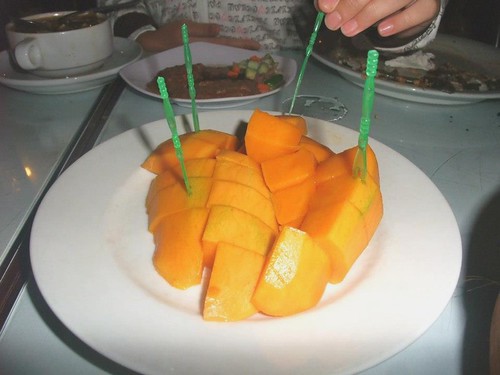
Fresh mangoes
A sweet end to our meal. That plate above? Those cubes come from only 1 mango.
These mangoes were not part of the package. There were on display up front, near the entrance. Seems like it's a breed from those 'high-end cultivars'. Somewhere along the line of the famous 'Alphonso' mangoes.
The mango flesh was thick, very sweet and only slightly sour. Definitely juicy.
And yes, a bit pricey. :P
So there's our experience, dining at an established Sundanese restaurant. It's almost a must to try dining at one when in Bandung. It's just like how you must try eating 'tom yam' when in Thailand.
Next up will be this delightful experience of dining at the famous Kampung Daun Restaurant. Coming soon.. I hope!
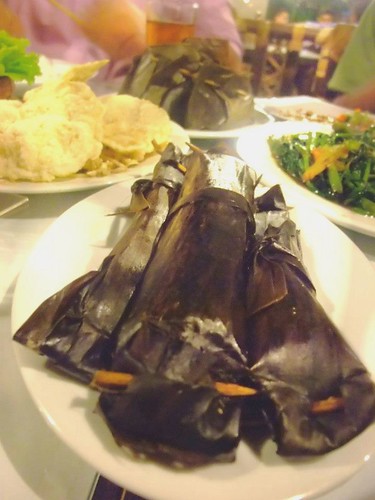

No comments:
Post a Comment